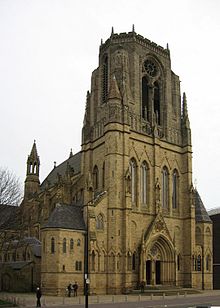The Holy Name Church Manchester
| Holy Name Church | |
|---|---|
| Church of the Holy Name of Jesus, Chorlton on Medlock | |

View of the entrance
|
|
| Coordinates: 53°27′52″N 2°13′52″W / 53.4645°N 2.2311°W | |
| OS grid reference | SJ8475796438 |
| Location | Manchester |
| Country | UK |
| Denomination | Roman Catholic |
| Website | www |
| History | |
| Founded | 15 October 1871 |
| Founder(s) | Bishop William Turner |
| Dedication | Holy Name of Jesus |
| Consecrated | 1923 |
| Architecture | |
| Status | Chapel of ease |
| Functional status | Active |
| Heritage designation | Grade I |
| Designated | 18 December 1963 |
| Architect(s) | J. A. Hansom and Son |
| Architectural type | Church |
| Style | Gothic Revival |
| Groundbreaking | 1869 |
| Completed | 1928 |
| Specifications | |
| Capacity | 800 |
| Length | 186 ft (57 m) |
| Width | 122 ft (37 m) |
| Spire height | 185 ft (56 m) |
| Materials | Moulded Terracotta Warwick Bridge stone |
| Administration | |
| Parish | St. Augustine Church |
| Deanery | Chorlton-on-Medlock |
| Diocese | Salford |
| Province | Liverpool |
| Clergy | |
| Bishop(s) | Rt. Rev. John Arnold |
| Rector | Fr Ian Tomlinson SJ |
| Priest in charge | Fr Tim Byron SJ |
| Priest(s) | Fr William Pearsall SJ |
| Laity | |
| Director of music | Mr Luke Mather |
| Organist(s) | Mr Simon Leach |
| Music group(s) | Mrs Sarah Insall |
| Parish administrator | Br Ken Vance SJ |
The Church of the Holy Name of Jesus on Oxford Road, Manchester, England was designed by Joseph A. Hansom and built between 1869 and 1871. The tower, designed by Adrian Gilbert Scott, was erected in 1928 in memory of Fr Bernard Vaughan, SJ. The church has been Grade I listed on the National Heritage List for England since 1989, having previously been Grade II* listed since 1963.
In 1860, William Turner, the first bishop of Salford, invited the Jesuits to make a home in Chorlton-on-Medlock, at the time a middle class suburb.
As well as the growing middle classes, Manchester was home to a large and expanding population of Irish immigrants who migrated to work in cotton manufacturing, especially after the Great Famine. In the area known as Little Ireland, the Parish of St Mary, Mulberry Street was unable to cope; in twenty years, thirteen priests had succumbed to typhus whilst working amongst the city's poor.
The Jesuits had a formidable record of outreach and missionary work, and this was put to good use. Whilst he was rector from 1888 to 1901, Fr Bernard Vaughan SJ took part in a series of debates with the Anglican Bishop of Manchester, James Moorhouse, over rival claims of the Catholic Church in England and Wales and the Church of England to be the Catholic Church in England and successor of St. Augustine. In their jubilation, the young men of Holy Name pulled his carriage from the city centre all the way to the church.
...
Wikipedia


